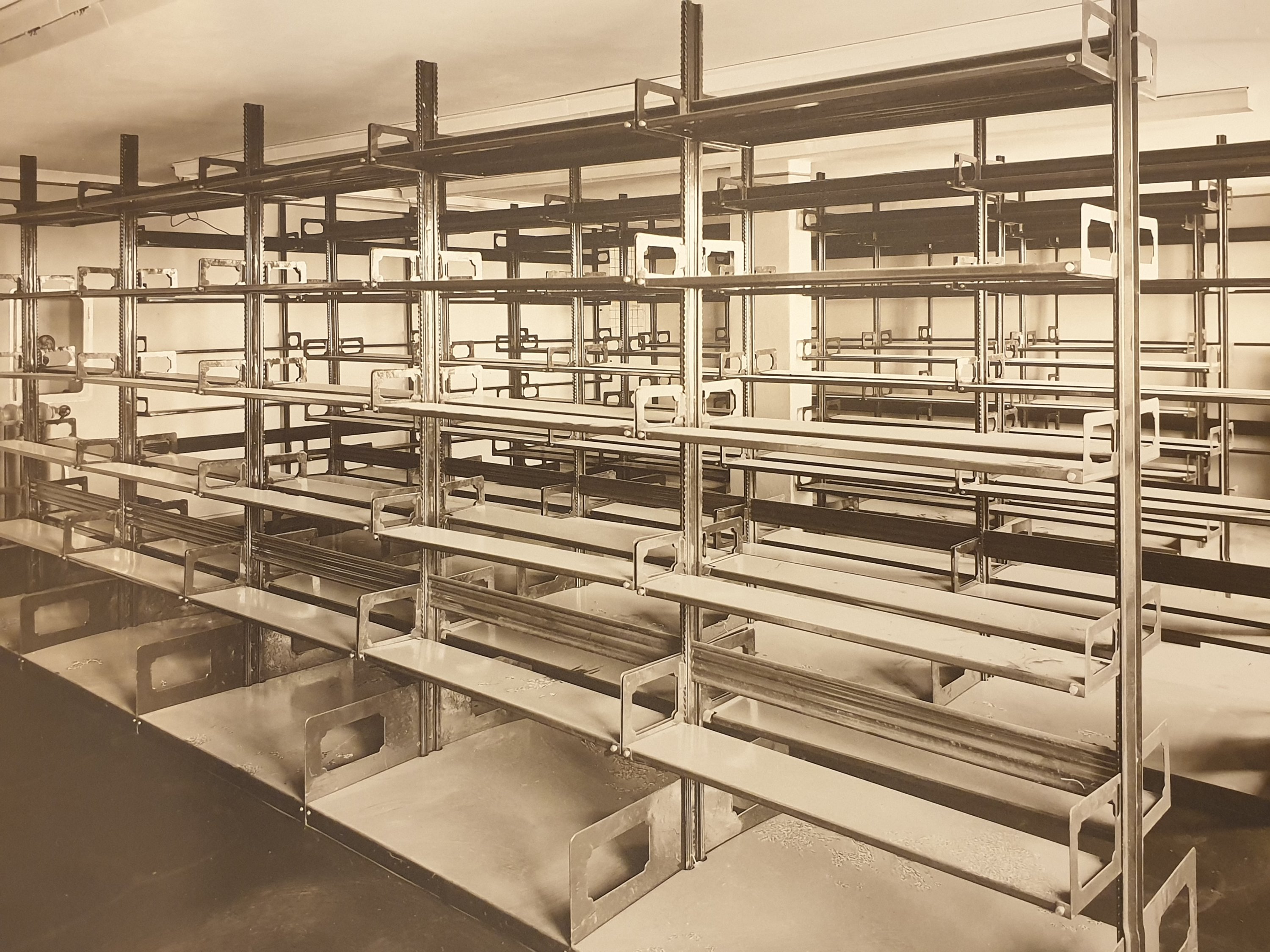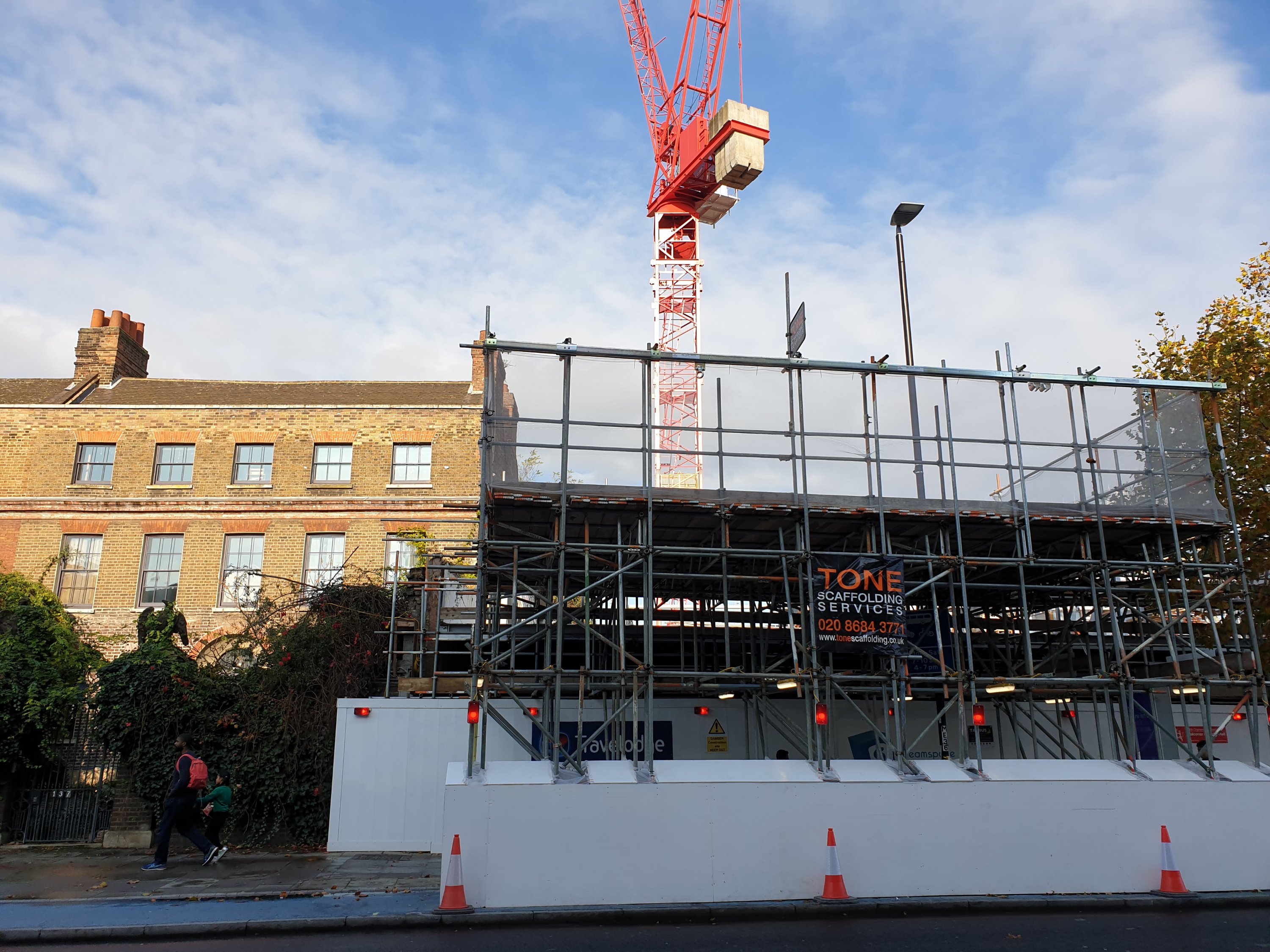The other thing I learned last night was a bit more about the house which Godfrey Samuel of Tecton designed for Fritz Saxl, the Director of the Warburg Institute, and Gertrud Bing, his assistant and, one assumes, lover, although the house consisted of two apartments, separate but identical, one on top of the other. Samuel was a member of the MARS Group and, together with Elisabeth Benjamin, had been involved in work helping German Jewish refugees, which may have been how they met. The house wasn’t built, but he was responsible for the design of the Warburg Institute’s temporary library at Thames House, which Anstey showed bore some resemblances to Tecton’s gorilla house for London zoo. Not long afterwards, in 1937, Samuel and his partner, Valentine Harding, designed Overshot a half-modernist house on the outskirts of Oxford for Ellis Waterhouse’s mother, after the sale of their family house, Shotover, and which Waterhouse himself lived in after retiring from the Barber Institute in Birmingham.
Monthly Archives: November 2019
Warburg Institute (1)
I went to a fascinating lecture by Tim Anstey of the Oslo School of Architecture about the different forms of the Warburg Institute Library: first, in the 1920s, next door to Warburg’s house, which originated the four floors of stacks from which books were fetched by an industrial system of elevators; then, flat, in Thames House, in space provided on a three-year lease in the 1930s by Lord Melchett, with furniture shipped from Hamburg; then in glorious, gothic confusion in the Imperial Institute, where Frances Yates did her research and Anthony Blunt was a research fellow; and then in a curious hybrid in a corner site in Woburn Square which combines Gertrud Bing’s liking for systematic, industrial order with (which I had not known) a desire to replicate the neo-Georgian character of the Fogg Art Museum, as required by Viscount Lee of Fareham as a condition of his support for the Courtauld Institute, which was planned to be next door.
This is the gothic disorder of the library when it was in South Kensington:-

And these are the first floor book stacks before they were filled with books in 1958:-

Marina Abramović
We went to a talk by Marina Abramović last night: actually, it was more in the order of a performance, because she has a way of holding one’s attention which is deeply theatrical, based on her presence and the way she speaks, as much as what she says. What she demonstrated very clearly was how her performances have evolved from small-scale, one-off, 1970s happenings – the invitation to an audience in Naples to do what they liked to her naked body, which they did, the arrow pointed at her heart by her lover Ulay – to mass, public, therapeutic events, invitations to people to pay attention to who they are, filling football arenas with a participatory art event, a healer of men. It will be fascinating to observe the public’s response to her exhibition at the RA next year.
O’Mast
We watched O’Mast last night, a documentary about Neapolitan tailoring. I had not realised how seriously tailoring is taken in Naples, with a great number of elderly, experienced master tailors, who were willing to hold forth about the nature of their art and, most especially, the relationship it involves to their clients. The quality of their tailoring is often nearly invisible – and is expected to be – wilfully unobtrusive, everything still done by hand, as soft cloth is carefully shaped to the sitter, like a portrait.
Façadism
Another issue that I have not been paying attention to during the battle to save the Whitechapel Bell Foundry is the Gentle Author’s simultaneous campaign against façadism, which has now resulted in a very handsome and beautifully produced short book which illustrates a set of case studies.
The classic example of the genre is Wellington House in Waterloo Road, where only the façade was retained in the late 1970s. What the Gentle Author effectively demonstrates is how much more common this is becoming: keeping a façade only, while the rest of the building behind is radically redeveloped – often an unsatisfactory compromise, keeping only the vestige of the original historic building as the lipstick on the pig. It’s good that he has drawn this to everyone’s attention.
I thought I saw a good example last weekend (it turns out it was just an extra-thin building backing onto the underground line):-

Travelodge
Because I have been focussing on the issues surrounding the development of the Whitechapel Bell Foundry, I have not been paying so much attention to the development of the new hotel nearly right next door to us. It was previously a branch of Topps Tiles, a big warehouse of zero architectural interest. The site, which is immense, was bought by Travelodge. They drew up plans which, to give them their due, were subject to close consultation with the local community, most especially the Spitalfields Trust, who gave detailed advice, which was followed, on the form and character of the street frontage, so that it included a run of small shops to help integrate the development with the street.
Well, half way through the construction, they have changed the scheme, so that the hotel entrance is on the street where there is no parking, thereby ignoring the advice they were given. Tower Hamlets as the local planning authority has not objected.
You can see the relevance of this to the Bell Foundry. One set of plans is approved to obtain planning permission. And then they are changed during construction. And Tower Hamlets watches complacently as the sense of history and local community is destroyed:-

Whitechapel Bell Foundry (3)
I hope sincerely that it may be possible to contest the decision on the Whitechapel Bell Foundry. But, meanwhile, it seems that there are two things which have gone very wrong in the advice that has been given.
1. I found out by accident that the issue has never been discussed by the Commissioners of Historic England. They were never told that there was an alternative scheme prepared by a very experienced charity which has previously worked on an equivalent project in Stoke-on-Trent. They were just informed that the Foundry had closed and so remain apparently oblivious of the issues which the case has raised and the amount of ill feeling that it has engendered locally (and internationally). Since the case has been running for two years, this strikes me as negligent.
2. At the heart of Historic England’s advice in favour of turning the Foundry into a hotel is a view that, so long as the ground plan and built fabric of the Foundry is retained, it does not matter, and is not relevant, if the use of the spaces changes from a working Foundry to a café/restaurant. But their mandate is surely not just purely about architecture, but about history as well. They are called HISTORIC England. And the Foundry was unique in the way that it preserved a sense of history, of labouring practices, of London as a working capital, not just a pleasure dome. I feel strongly that the Commissioners should discuss and take a view on this, rather than just be complacently subservient to the advice of their officers.
Perhaps this could be a topic of judicial review ?
Whitechapel Bell Foundry (2)
I have been searching the internet as to how last night’s planning meeting went.
Three for and three against. The chairman gave his casting vote in favour of the scheme. Thus is a long history, a history of continuous active use since the Middle Ages, a building which has made and created bells since the 1740s, abolished by a single vote through a bureaucratic system which has been warped and corroded in favour of redevelopment: another cappuccino bar; but a unique history of continuous industrial use will be lost.
Art + Christianity Award (2)
I am now pasting the portion of my speech, which dealt with the other books on the shortlist, because it was a very strong shortlist and difficult to choose a winner:-
• Jonathan A Anderson and William Dyrness’s book Modern Art and the Life of a Culture, published by the Intervarsity Press. We all liked and admired it: clear, authoritative, scholarly and wide-ranging.
• T J Clark’s brilliant, thought-provoking, beautifully written and powerful book, Heaven on Earth, published by (and, incidentally, beautifully produced by) Thames & Hudson. We loved it: a major book written with great passion.
• Tom Crow’s No Idols: The Missing Theology of Art, published by Power Polemics in Australia: a book by an art historian, who is the former Director of the Getty Research Institute, now at the Institute of Fine Arts in New York; a very thoughtful and reflective book.
• Neil MacGregor’s Living with the Gods, published, and like the Clark book, beautifully produced by Allen Lane, in conjunction with the BBC: an extraordinarily authoritative, wide-ranging, lucid survey of imagery by a great public advocate for looking at, and thinking about, the characteristics of imagery of different faiths.
• Chloë Reddaway’s Strangeness and Recognition, published by Brepols, a model of its kind: thoughtful, deeply serious, and about the central issue of the relationship between theology and image-making.
• Ittai Weinryb’s Agents of Faith, published by Yale University Press on behalf of the Bard Graduate Center Gallery in New York, is a book which is different in kind and character from the other books, because it is multi-author, written by a wide range of international scholars who collaborated over a long period of time in writing about the nature of votive objects in different historical and cultural arenas, in advance of an exhibition held at the Bard Center a year ago. As we talked about the book and discussed its many virtues, including its sense of intellectual authority and academic coherence, it became clear that we all admired it hugely for its originality, its wide compass, and the fact that it was an exhibition catalogue which, somewhat unusually for an exhibition catalogue, makes a major scholarly contribution to its subject.
• We agreed to award the prize to Itaai Weinryb as the book’s general editor and he flew over from New York especially to collect the award.
Whitechapel Bell Foundry (1)
Tonight may or may not see the end of the long local and national campaign to try and save – and reinstate – the Whitechapel Bell Foundry, one of the great historic sites of East London, on a par in its way with the Trinity Almshouses up the road whose threatened demolition led to the foundation of the Survey of London and the realisation that we need forever to make determined efforts to keep portions, relics of the world we are in danger of losing: in the case of the Bell Foundry, the continuity of manufacture in a type of object of such symbolic resonance. Now, there is a risk that it will become just another boutique hotel, an empty shell, and a cafeteria. Memory will have gone. And the continuity of workshop practices, the importance of labour to an understanding of the historic environment. But I nearly forgot. It is Historic England, the government agency charged with protecting the historic environment, which has recommended its loss.
https://spitalfieldslife.com/2019/11/14/d-day-for-the-whitechapel-bell-foundry/

You must be logged in to post a comment.